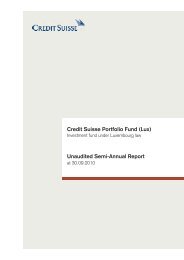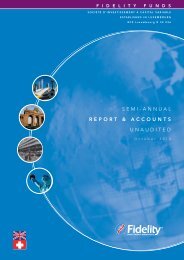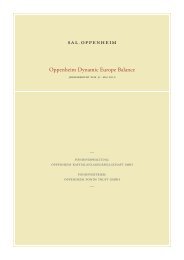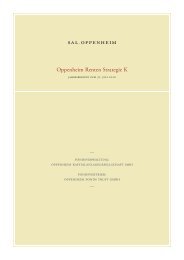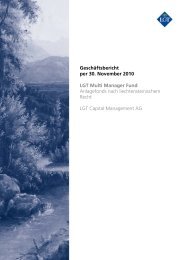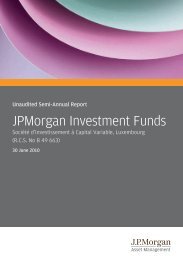Verkaufsprospekt
Verkaufsprospekt
Verkaufsprospekt
Sie wollen auch ein ePaper? Erhöhen Sie die Reichweite Ihrer Titel.
YUMPU macht aus Druck-PDFs automatisch weboptimierte ePaper, die Google liebt.
are applied and any recent developments in the risk and<br />
yield characteristics of the main categories of investments.<br />
A list of the stock exchanges and markets in which the<br />
Sub-Fund is permitted to invest, in accordance with the<br />
requirements of the Central Bank, is contained in Appendix<br />
I to the Prospectus and should be read in conjunction with,<br />
and subject to, the Sub-Fund's investment objective and<br />
investment policy, as detailed above. The Central Bank<br />
does not issue a list of approved markets. With the exception<br />
of permitted investments in unlisted securities, investment<br />
will be restricted to those stock exchanges and markets<br />
listed in Appendix I to the Prospectus.<br />
The risk factors specific to the Sub-Fund are set out in<br />
section 4 below and includes FDI, Small Capitalised Companies<br />
Risk and Volatility Risk. These risk factors may not<br />
be a complete list of all risk factors associated with an<br />
investment in the Sub-Fund.<br />
4. Additional Risk Factors<br />
The general risk factors set out in the "Risk Factors" section<br />
of the Prospectus apply to the Sub-Fund. In addition,<br />
the following additional risk factors apply to the Sub-Fund.<br />
The risk factors may not be a complete list of all risk factors<br />
associated with an investment in the Sub-Fund:<br />
Financial Derivative Instruments: The prices of derivative<br />
instruments, including futures and options prices, are<br />
highly volatile. Price movements of forward contracts,<br />
futures contracts and other derivative contracts are influenced<br />
by, among other things, interest rates, changing<br />
supply and demand relationships, trade, fiscal, monetary<br />
and exchange control programs and policies of governments,<br />
and national and international political and economic<br />
events and policies. In addition, governments from<br />
time to time intervene, directly and by regulation, in certain<br />
markets, particularly markets in currencies and interest<br />
rate related futures and options. Such intervention is often<br />
intended directly to influence prices and may, together with<br />
other factors, cause all of such markets to move rapidly in<br />
the same direction because of, among other things, interest<br />
rate fluctuations.<br />
The use of FDI also involves certain special risks, including:<br />
(1) dependence on the ability to predict movements in<br />
the prices of securities being hedged and movements in<br />
interest rates, (2) imperfect correlation between the price<br />
movements of the derivatives and price movements of<br />
related investments, (3) the fact that skills needed to use<br />
these instruments are different from those needed to select<br />
the Sub-Fund’s securities, (4) the possible absence of a<br />
liquid market for any particular instrument at any particular<br />
time, (5) possible impediments to effective portfolio management<br />
or the ability to meet redemptions, (6) possible<br />
legal risks arising in relation to derivative contract documentation,<br />
particularly issues arising relating to enforceability<br />
of contracts and limitations thereto, (7) settlement<br />
risk as when dealing with futures, forwards, swaps, contracts<br />
for differences the Sub-Fund’s liability may be potentially<br />
unlimited until the position is closed, and (8) counterparty<br />
risk as the use of OTC derivatives, such as futures,<br />
forward contracts, swap agreements and contracts for<br />
differences will expose the Sub-Fund to credit risk with<br />
PineBridge US Small Cap Growth Fund<br />
respect to the counterparty involved.<br />
The Sub-Fund may invest in certain derivative instruments,<br />
which may involve the assumption of obligations as well as<br />
rights and assets. Assets deposited as margin with brokers<br />
may not be held in segregated accounts by the brokers<br />
and may therefore become available to the creditors of<br />
such brokers in the event of their insolvency or bankruptcy.<br />
Small Capitalised Companies Risk: Investments in small<br />
capitalised companies may involve greater risk than is<br />
customarily associated with larger, more established companies.<br />
The securities of small or medium-sized companies<br />
are often traded over-the-counter, and may not be<br />
traded in volumes typical of securities traded on a national<br />
securities exchange. Consequently, an investment in securities<br />
of smaller capitalised companies may be more illiquid<br />
than that of larger capitalisation stocks and may be subject<br />
to more volatility than securities of larger, more established<br />
companies. In addition, the quality, reliability, and availability<br />
of information for smaller to mid capitalisation companies<br />
may not provide the same degree of information and<br />
may be less transparent than investors would generally<br />
expect from large capitalisation companies. Rules regulating<br />
corporate governance may be underdeveloped or less<br />
stringent than regulations applicable to large capitalisation<br />
companies which may increase investment risk and offer<br />
little protection to investors.<br />
Volatility Risk: All markets are subject to volatility based<br />
on prevailing economic conditions. Securities in 'emerging'<br />
or 'developing' markets may involve a higher degree of risk<br />
due to the small current size of the markets for securities<br />
of 'emerging' or 'developing' market issuers and the currently<br />
low or non-existent volume of trading, which could<br />
result in price volatility. Certain economic and political<br />
events in 'emerging' or 'developing' economies, including<br />
changes in foreign exchange policies and current account<br />
positions, could also cause greater volatility in exchange<br />
rates. As stated previously, some of the markets or exchanges<br />
on which a Sub-Fund may invest may prove to be<br />
highly volatile from time to time.<br />
5. Application for Units<br />
The following classes of Unit are currently, or may be,<br />
offered:<br />
Class A Units denominated in US Dollars<br />
Class A1 Units denominated in Euro<br />
Class A2 Units denominated in Sterling<br />
Class A3 Units denominated in Japanese Yen<br />
Class C Units denominated in US Dollars<br />
Class C1 Units denominated in Euro<br />
Class C2 Units denominated in Sterling<br />
Class C3 Units denominated in Japanese Yen<br />
Class H Units denominated in US Dollars<br />
Class Y Units denominated in US Dollars<br />
Class Y1 Units denominated in Euro<br />
Class Y2 Units denominated in Sterling<br />
Class Y3 Units denominated in Japanese Yen<br />
| 242



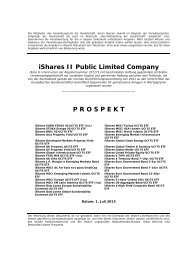
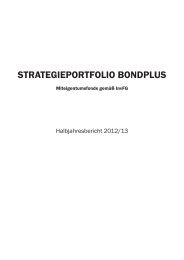

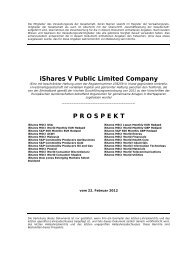
![Prospectus Simplifié daté de [Mars] 2005](https://img.yumpu.com/18875582/1/190x245/prospectus-simplifie-date-de-mars-2005.jpg?quality=85)

